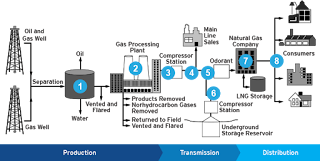Natural gas is brought from underground up to the wellhead from different place. Processing of natural gas is simple than separation of oil. Raw natural gas comes from different sources. They are
- Oil wells,
- Gas wells,
- Condensate wells
Natural gas that comes from oil wells is termed as associated gas. This gas can exist separate from oil in the formation is called as free gas. Dissolved in the crude oil is called as dissolved gas. Natural gas from gas and condensate wells, in which there is no crude oil, is called as nonassociated gas. Gas wells typically produce raw natural gas by itself, while condensate wells produce free natural gas along with a semi-liquid hydrocarbon condensate. Whatever the source of the natural gas, once separated from crude oil (if present) it commonly exists in mixtures with other hydrocarbons; principally ethane, propane, butane, and pentanes. In addition, raw natural gas contains water vapor, hydrogen sulfide (H2S), carbon dioxide, helium, nitrogen, and other compounds.
Natural gas is processed pure natural gas, that is pipeline quality dry natural gas. Major transportation pipelines usually impose restrictions on the make-up of the natural gas that is allowed into the pipeline. Before the transportation of natural gas it must be purified. While the ethane, propane, butane, and pentanes must be removed from natural gas, this does not mean that they are all waste one.
Associated hydrocarbons, known as natural gas liquids (NGL) can be very valuable by-products of natural gas processing. Natural gas liquids are ethane, propane, butane, i-butane and natural gasoline. These NGL are sold separately and used for various process; including enhancing oil recovery in oil wells, providing raw materials for oil refineries or petrochemical plants.
For the processing of natural gas, it is transported for long distance. Small size pipe is used. Here the pressure will be high.
Image courtesy: https://www2.dteenergy.com
Main processes involved in gas processing
- Removal of oil and condensate
- Removal of water
- Removal of NGL
- Removal of sulfur and carbon dioxide
1. Removal of oil and condensate
Here the natural gas with oil or condensate is passed through the separator. Low temperature separator is used to remove the oil. Here oil is removed from the raw natural gas. And other liquds are removed in low temperature separator.
2. Removal of water
Here two methods are used to remove water form the wet gas. They are,
Absorption
Here dehydrating agent is added to remove water from the wet gas. Glycol is used for this process as dehydration agent. Water has greatest affinity glycol. So water will combine with glycol and removed from the column. Then this mixture is moved to boiler and water is removed from the mixture and the glycol is reused.
Adsorption
Water is adsorbed on the surface of the adsorbent.
3. Removal of NGL
Absorption process is used to remove NGL for the natural gas. It is similar to glycol dehydration process. An absorbing oil is used to remove NGL from gas.
4. Removal of sulfur and carbon dioxide
Natural gas from some wells contains small amount of sulfur and carbon dioxide. This natural gas, because of the rotten smell provided by its sulfur content, is commonly called as sour gas. Sour gas is undesirable because the sulfur compounds it contains can be extremely harmful, to breathe. Sour gas can also be extremely corrosive. Sweetening process is used to remove sulfur and carbon dioxide. It is also known as amine process. Because amine is used to remove sour gas. Amine contact tower is used. Amine is recycled and reused then pure natural gas is separated.
